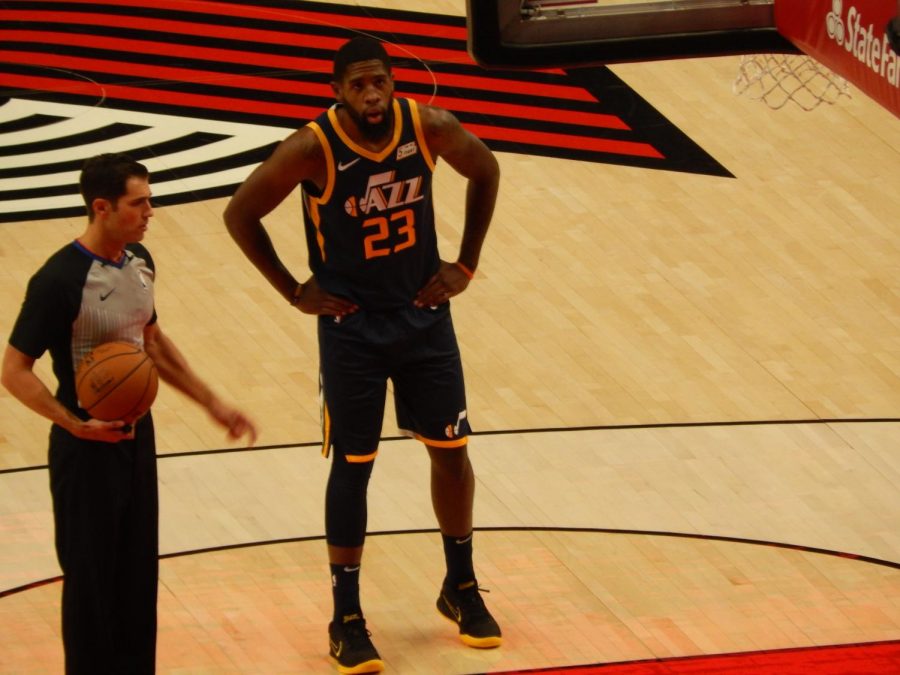Utah Jazz Season Grades: Part 1
July 18, 2021
It’s been more than three weeks since the Utah Jazz storybook 2020-21 season came to an end in unceremonious fashion at the hands of the LA Clippers. Jazz fans are trying to rationalize how a 52-win, top-of-the-Western-Conference team could fail so spectacularly come playoff time.
So how did the Jazz lead the West and give themselves a chance to contend for a title? Three all-stars, incredible shooting depth and a bench that featured numbers 1 and 2 in Sixth Man of the Year voting. In this two-part story, I will be grading each player’s performance during the 2020-21 season. So without further ado, let’s get started.
Rudy Gobert
Gobert is an ultimate floor-raiser. When Gobert is on the floor, he can take one of the league’s worst defensive units and transform them into a top ranked D. With Gobert anchoring the post, the defense of the Jazz revolves around the guy with the longest standing reach in NBA combine history.
What do RAPTOR, LEBRON & ESPN Defensive Real +/- have in common? They’re all analytical barometers, far too complicated for me to understand, that show not only that Gobert was far and away the best defensive player in the NBA during the 2020-21 season, but that he put together one of the most dominant defensive campaigns ever. Finishing second in the league in blocked shots and rebounds with 2.7 blocks and 13.5 rebounds, the box score shows his importance as well.
Often considered a negative on the offensive end, Gobert led the league for the third consecutive season in dunks, finishing with 231 in 2020-21. While he can be bullied at times and his lack of an effective post move has been exploited in the playoffs, Gobert is the straw that stirs this Jazz drink on both ends of the floor. A 3-time Defensive Player of the Year, Gobert can just let his hardware do the talking now.
Final Grade — A
Donovan Mitchell
Mitchell made his second consecutive all-star appearance this year and, until a late-season ankle injury that cost him the final 16 games of the regular season and reared its ugly head once again in the conference semifinals, had Jazz fans making parade plans to celebrate a title.
Unfortunately injuries struck at the worst moments, limiting Mitchell’s effectiveness offensively and sapping any lateral movement he had on the defensive end.
After Donovan’s explosion in the playoff bubble last season, many wondered if Mitchell could maintain a similar level of play. This year, Mitchell became one of the league’s deadliest three-point shooters, connecting on 178 threes at a near 39% rate, a significant increase over his previous efficiency.
In spite of the ankle injury, Mitchell gave his all to the Jazz in the playoffs. Shooting 43.9% from beyond the arc, Mitchell made 3 threes per game and managed to improve his playmaking with nearly 5.5 assists per game. If Gobert is the floor for the Jazz, Mitchell’s dynamism represents the ceiling.
Final Grade — A
Mike Conley
Entering the season, Conley was widely considered to be the best active player to never make an All-Star team. Thanks to stellar early season play from Conley and the Jazz as a whole, Conley was named as an injury replacement for the ASG in Atlanta.
Make no mistake, Conley was great statistically for the Jazz this season, especially when compared to his struggles in Quin Snyder’s offensive system last year. Per 36 minutes, Conley averaged 19.9 points on 41% 3-point shooting, with 7.3 assists, and ran the offense like the seasoned veteran he is.
Conley’s value really showed itself when he re-aggravated a mid-season hamstring injury during Game 5 of the first round against Memphis. Without Conley for a majority of round 2 against the Clippers, the Jazz offense bogged down and not having his shooting on the perimeter allowed LA to play a five-out lineup that limited Gobert’s defensive effectiveness.
If the Jazz cannot re-sign the free agent, expect a step back for the team next year.
Final Grade — B+
Royce O’Neale
Is O’Neale one of the most underrated players in the league? According to fivethirtyeight.com, nobody defended their opponents’ best scorer more consistently than O’Neale. A physical athlete that might be the toughest player on the team, O’Neale sets a tone nightly with his defensive intensity.
Defense isn’t the only way O’Neale earns his money though. As 3 & D type players have skyrocketed in value across the league, O’Neale is perfect for this Jazz system and fits the 3 & D role well. Shooting 38% from three, I’d love to see him be a little more willing to pull the trigger on some contested threes to compliment the Jazz spacing.
Final Grade — B+
Bojan Bogdanović
Returning from off-season surgery on his shooting wrist, it was hard to know exactly what to expect from Bogdanović coming into this season. A lack of consistency is what hurt Bogdanović this season. One night he’d score 23 points with five threes, the next he’d go 1-3 from the field and score four points.
Turnovers on postups had Jazz fans cringing every time Bogey put the ball on the floor with his back to the basket, and a complete unwillingness to contribute in other areas on the floor made Bogdanović a liability at times.
So, how does he get a decent grade with all the negatives mentioned above? He shot 39% from three and could be lethal from the paint, midrange and beyond the arc. When Bogdanović got enough touches to stay in a rhythm, he was great. Unfortunately for the Jazz, that version of Bogdanović just didn’t come around enough.
Final Grade — C+
Jordan Clarkson
Across the first six weeks of the season, Jordan Clarkson was as hot as he’s ever been in his career. 25 points per 36 minutes on 46% shooting from the field and 38% beyond the arc, Clarkson solidified his Sixth Man of the Year award before February.
In sports, whenever a player gets unbelievably hot, they are bound to return to earth at some point. For Clarkson, the fall came in February. Nagging ankle and hand injuries sapped his efficiency, relegating Clarkson to his career norms. Clarkson still had great performances here and there, but struggled to find any consistency with his three point shot for the remainder of the season.
The playoffs didn’t get much better for Clarkson, but the fact remains that he is an integral piece to the Utah Jazz offense.
Final Grade — B
Joe Ingles
One of the best trash-talkers in basketball, Ingles was piecing together a career year before injuries forced him into the primary ball handler, point guard role to close the season. At 33 years old and behind the 8-ball athletically, Ingles appeared to wear down as the season progressed.
Finishing second behind Clarkson in Sixth Man of the Year voting, Ingles averaged 15.6 points, 4.7 rebounds and 6.1 assists per 36 minutes this year. A steadying influence of the bench, Ingles might be as important in the locker room as he is on the court.
Final Grade — B
Derrick Favors
After spending a year in New Orleans, Favors returned home to the Utah Jazz on a three-year contract. The plan was to have Favs serve as the primary backup for Gobert. When it comes to Gobert, the plan worked spectacularly. Gobert was able to feast in minutes against the opponents backup center while Favors battled the starter. Unfortunately for Favors, facing opponents’ starters in a majority of his minutes had the opposite effect for his numbers.
By the eye-test, Favors was overmatched and struggled this season, but a deeper dive shows us that teams attacked the basket relentlessly with Gobert off the floor. Personally, I don’t believe Favors’ struggles were due as much to his own limitations as they can be attributed to the simple fact that he isn’t Gobert.
All that being said, Favors is a great locker room guy but he’s probably overpaid when you look at backup center compensation across the league.
Final Grade — C
Georges Niang
Some wondered if Niang would not only have a rotation spot this season, but whether or not he even deserved a roster spot. After a horrendous start to the year in which Niang shot 1-9 in the first seven games, he rebounded to nail down a rotation spot and play some important minutes off the bench for the Jazz.
Per 36 minutes, Niang’s 3.9 three pointers made was behind none when it comes to Jazz regulars. Suffice to say, Niang was a sniper and probably reached the ceiling of his NBA potential. Playoff struggles drop Niang’s grade slightly, but he earned himself a sizable raise on a new contract from somebody next season.
Final Grade — B+
Stay tuned for part 2 next week.








